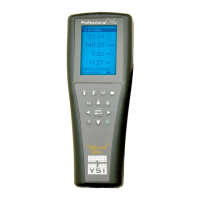Nitrate
The nitrate sensor should be calibrated every day the instrument is used. The nitrate sensor should only be used
in fresh water (salinity < 2 ppt) and to depths of 55 feet (17 meters) of water.
CALIBRATION TIPS
1. If using a nitrate sensor with either a pH or ORP sensor on a 6051010 or Quatro cable, install the pH or ORP
sensor in port 1 and the nitrate sensor in port 2.
2. If using a nitrate sensor on a 6051010 or Quatro cable, calibrate the sensor in port 1 prior to calibrating the
sensor in port 2. The sensor in port 2 uses the reference of the sensor installed in port 1. Therefore, it is
important to verify that the sensor in port 1 is working properly before calibrating the sensor in port 2. See
nitrate Troubleshooting Tips for additional information on port configuration.
3. Exposure to the high ionic content of pH buffers can cause a significant, but temporary, drift in the nitrate
sensor. Therefore, if calibrating a pH sensor, either:
a. Remove the nitrate sensor from the cable bulkhead and plug the port. After pH calibration is
complete, reinstall the nitrate sensor and proceed with its calibration with no stabilization delay.
Or
b. Calibrate pH first, immersing both sensors in the pH buffers. After calibrating pH, place the sensors
in 100 mg/L nitrate standard and monitor the reading. Usually, the reading starts low and may take
awhile to reach a stable value. When it does, proceed with the calibration. This may take several
hours.
4. The nitrate sensor can be calibrated with up to three calibration points. For highest accuracy, perform a two
point calibration with 1 and 100 mg/L standards within 10°C of your sample temperature
.
5. Rinse the sensors and cal cup with a small amount of nitrate solution (1 mg/L for the first point and 100 mg/L
for the second point). Fill the cup so that the nitrate sensor tip and the temperature sensor are submerged in
solution. If using a Quatro cable or 6051030 cable, ensure that the conductivity sensor is also submerged in
the calibration solution. The salinity reading from the conductivity sensor is used in the algorithm for the
nitrate measurement.
6. After entering the calibration screen, change the calibration value if necessary.
7. If not using a conductivity sensor, enter the salinity value of the calibration standard. After calibration, change
the salinity correction value to the salinity value of the water you will be testing in the field in order to obtain
the most accurate nitrate measurement. You can change the salinity correction value in the Sensor menu.
As mentioned, the nitrate sensor should only be used in fresh water (salinity < 2 ppt). The salinity of fresh
water is typically 0 to 0.5 ppt.
8. Record the NO
3
millivolts for each calibration point. The acceptable mV outputs for each calibration solution
are shown below.
NO
3
1 mg/L = 200 mV +/- 20 mV (new sensor only) NO3 10 mg/L ≈ 150mV ± 20mV
NO
3
100 mg/L = 90 to 130 mV < 1 mg/L mV value
•
The mV span between 1 mg/L and 100 mg/L values should be
≈
90 to 130 mV. The slope should be
-45 to -65 mV per decade.
9. Wait for the nitrate and temperature readings to stabilize in each calibration solution and then press enter to
accept each calibration point.
10. Rinse the sensor and cal cup between calibration points with a small amount of the next buffer.
11. After pressing enter to accept your last calibration point, press cal
to complete the calibration. Otherwise
you will continue calibrating up to 3 calibration points.
12. If you receive a warning message stating that the calibration is questionable, do not
continue with the
calibration. Instead, select ‘No’ and investigate what is causing the questionable results. If you accept a
questionable calibration, your nitrate readings will be erroneous. Typical causes for this error message
include: incorrect Sensor/Port setup in the instrument, a dirty sensor or bad buffer solution.
18

